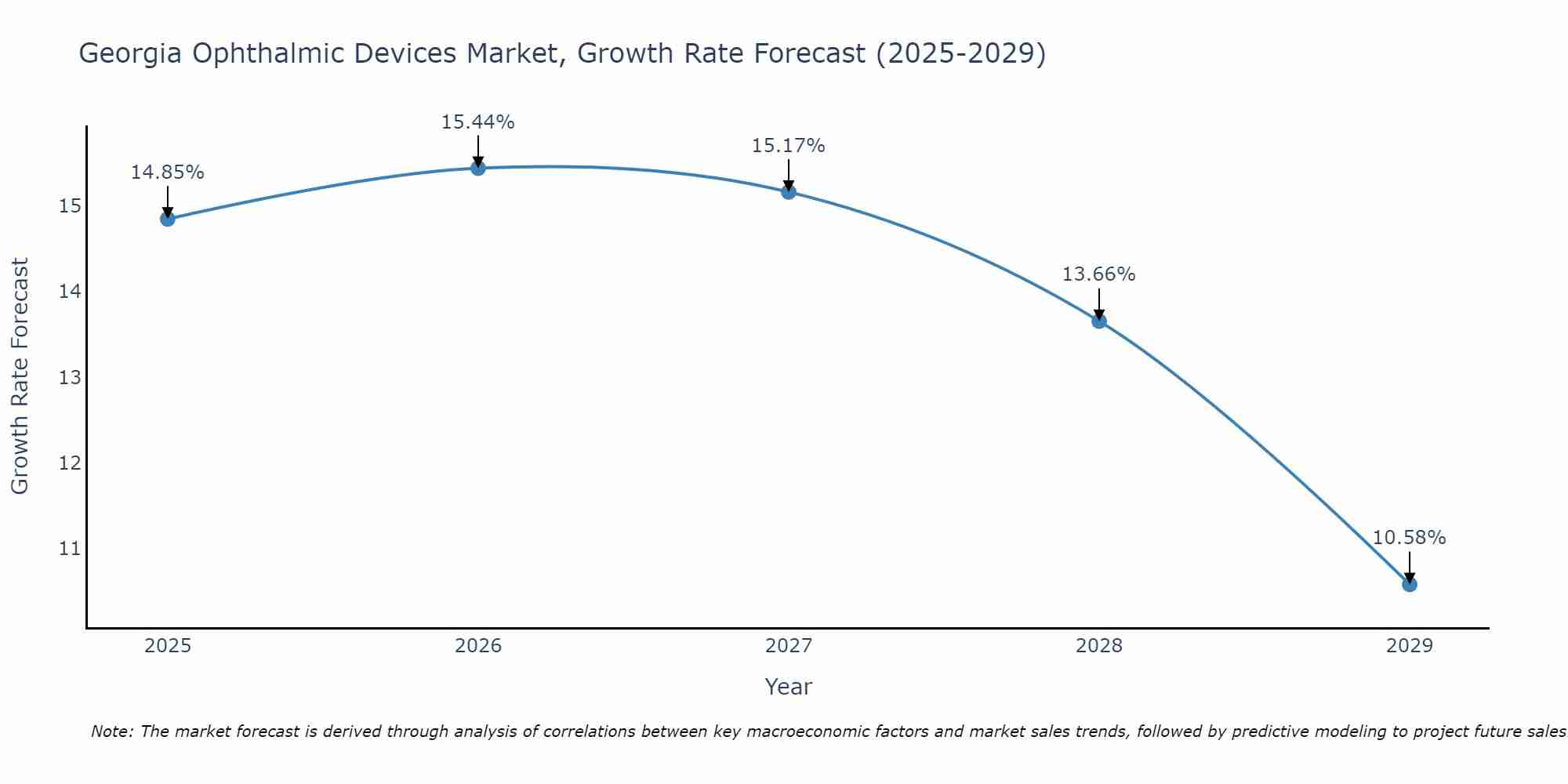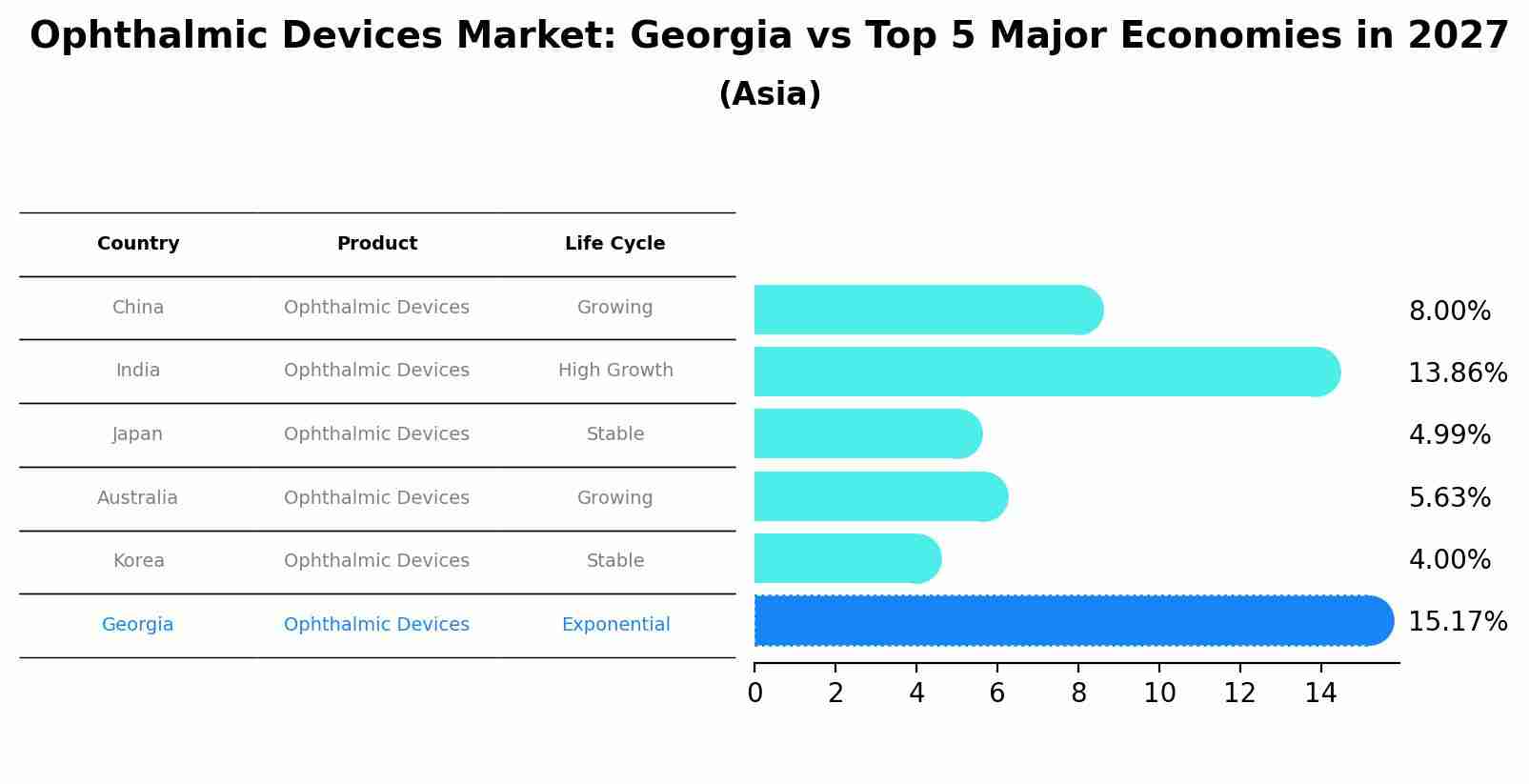Georgia Ophthalmic Devices Market Outlook | Companies, Trends, Forecast, Growth, Analysis, Size, Revenue, COVID-19 IMPACT, Share, Industry & Value
| Product Code: ETC367920 | Publication Date: Aug 2022 | Updated Date: Jul 2025 | Product Type: Market Research Report | |
| Publisher: 6Wresearch | Author: Shubham Padhi | No. of Pages: 75 | No. of Figures: 35 | No. of Tables: 20 |
Georgia Ophthalmic Devices Market Size Growth Rate
The Georgia Ophthalmic Devices Market is projected to witness mixed growth rate patterns during 2025 to 2029. The growth rate begins at 14.85% in 2025, climbs to a high of 15.44% in 2026, and moderates to 10.58% by 2029.

Ophthalmic Devices Market: Georgia vs Top 5 Major Economies in 2027 (Asia)
By 2027, the Ophthalmic Devices market in Georgia is anticipated to reach a growth rate of 15.17%, as part of an increasingly competitive Asia region, where China remains at the forefront, supported by India, Japan, Australia and South Korea, driving innovations and market adoption across sectors.

Georgia Ophthalmic Devices Market Synopsis
The Georgia Ophthalmic Devices Market is a dynamic and growing sector within the healthcare industry in the state. With a focus on eye care and vision health, the market offers a range of products including diagnostic devices, surgical instruments, vision correction tools, and other ophthalmic equipment. Key players in the market include both global companies and local manufacturers, catering to the diverse needs of ophthalmologists, optometrists, and eye care professionals in Georgia. The market is driven by factors such as increasing prevalence of eye disorders, advancements in technology, and rising demand for minimally invasive surgical procedures. Government initiatives promoting eye health awareness and accessibility to eye care services further contribute to the market`s growth trajectory in Georgia. Overall, the Georgia Ophthalmic Devices Market presents opportunities for innovation, collaboration, and improved patient outcomes in the field of eye care.
Georgia Ophthalmic Devices Market Trends
The Georgia Ophthalmic Devices Market is experiencing several key trends. One notable trend is the increasing demand for advanced diagnostic and surgical equipment in ophthalmology practices. This includes technologies such as optical coherence tomography (OCT) machines, advanced phacoemulsification systems for cataract surgery, and femtosecond laser systems for refractive surgery. Additionally, there is a growing focus on teleophthalmology services and remote monitoring solutions to improve access to eye care services in rural areas. Another trend is the adoption of innovative intraocular lenses (IOLs) with features like extended depth of focus or blue light filtering to address specific patient needs. Overall, the market is witnessing a shift towards more personalized and technologically advanced solutions to improve patient outcomes and enhance efficiency in ophthalmic practices.
Georgia Ophthalmic Devices Market Challenges
The Georgia ophthalmic devices market faces various challenges such as increasing competition from international players, rapid technological advancements leading to frequent product upgrades, stringent regulatory requirements, and the rising costs of research and development. Additionally, the market also encounters challenges related to reimbursement policies, pricing pressures, and the need for skilled professionals in the field of ophthalmology. Furthermore, changing consumer preferences, evolving healthcare policies, and the impact of the COVID-19 pandemic on healthcare systems have further added complexity to the market landscape in Georgia. To navigate these challenges successfully, companies operating in the Georgia ophthalmic devices market must focus on innovation, strategic partnerships, regulatory compliance, and market expansion strategies to maintain a competitive edge and meet the evolving needs of healthcare providers and patients.
Georgia Ophthalmic Devices Market Investment Opportunities
The Georgia ophthalmic devices market presents promising investment opportunities in areas such as advanced diagnostic equipment, surgical instruments, and vision correction technologies. With a growing aging population and increasing prevalence of eye-related disorders, there is a rising demand for innovative and efficient ophthalmic devices in the state. Investing in cutting-edge technologies for early detection of eye diseases, minimally invasive surgical tools, and advanced vision correction solutions could prove to be lucrative in the Georgia market. Additionally, partnerships with local eye care facilities and healthcare providers can help in expanding market reach and establishing a strong presence in the region. Overall, the Georgia ophthalmic devices market offers a fertile ground for investors looking to capitalize on the growing demand for high-quality eye care solutions.
Jordan Agar Market Government Policies
The Georgia Ophthalmic Devices Market operates within the broader regulatory framework set by the U.S. Food and Drug Administration (FDA), which oversees the safety and efficacy of medical devices. In addition to federal regulations, the state of Georgia may have its own specific requirements for ophthalmic devices, such as licensing and registration procedures. Healthcare facilities in Georgia are also subject to state healthcare regulations that govern the purchase and use of medical devices. It is crucial for ophthalmic device manufacturers and distributors operating in Georgia to stay informed about any updates or changes in regulations at both the federal and state levels to ensure compliance and market access.
Georgia Ophthalmic Devices Market Future Outlook
The Georgia Ophthalmic Devices Market is expected to witness steady growth in the coming years, driven by factors such as an aging population, increasing prevalence of eye disorders, advancements in ophthalmic technologies, and rising awareness about eye health. The demand for ophthalmic devices in Georgia is likely to be fueled by the need for early diagnosis and treatment of eye conditions, as well as the growing adoption of minimally invasive surgical procedures. Additionally, the increasing healthcare expenditure and supportive government initiatives aimed at improving eye care services are expected to further boost market growth. Market players are focusing on innovation and product development to meet the evolving needs of ophthalmologists and patients, which will contribute to the expansion of the ophthalmic devices market in Georgia.
Key Highlights of the Report:
- Georgia Ophthalmic Devices Market Outlook
- Market Size of Georgia Ophthalmic Devices Market, 2021
- Forecast of Georgia Ophthalmic Devices Market, 2031
- Historical Data and Forecast of Georgia Ophthalmic Devices Revenues & Volume for the Period 2018 - 2031
- Georgia Ophthalmic Devices Market Trend Evolution
- Georgia Ophthalmic Devices Market Drivers and Challenges
- Georgia Ophthalmic Devices Price Trends
- Georgia Ophthalmic Devices Porter's Five Forces
- Georgia Ophthalmic Devices Industry Life Cycle
- Historical Data and Forecast of Georgia Ophthalmic Devices Market Revenues & Volume By Product for the Period 2018 - 2031
- Historical Data and Forecast of Georgia Ophthalmic Devices Market Revenues & Volume By Optical Coherence Tomography Scanners for the Period 2018 - 2031
- Historical Data and Forecast of Georgia Ophthalmic Devices Market Revenues & Volume By Fundus Cameras for the Period 2018 - 2031
- Historical Data and Forecast of Georgia Ophthalmic Devices Market Revenues & Volume By Perimeters/Visual Field Analyzers for the Period 2018 - 2031
- Historical Data and Forecast of Georgia Ophthalmic Devices Market Revenues & Volume By Autorefractors and Keratometers for the Period 2018 - 2031
- Historical Data and Forecast of Georgia Ophthalmic Devices Market Revenues & Volume By Ophthalmic Ultrasound Imaging Systems for the Period 2018 - 2031
- Historical Data and Forecast of Georgia Ophthalmic Devices Market Revenues & Volume By Ophthalmic Pachymeters for the Period 2018 - 2031
- Historical Data and Forecast of Georgia Ophthalmic Devices Market Revenues & Volume By Tonometers for the Period 2018 - 2031
- Historical Data and Forecast of Georgia Optical Coherence Tomography Scanners Ophthalmic Devices Market Revenues & Volume By Slit Lamps for the Period 2018 - 2031
- Historical Data and Forecast of Georgia Ophthalmic Devices Market Revenues & Volume By Application for the Period 2018 - 2031
- Historical Data and Forecast of Georgia Ophthalmic Devices Market Revenues & Volume By Cataract for the Period 2018 - 2031
- Historical Data and Forecast of Georgia Ophthalmic Devices Market Revenues & Volume By Vitreo retinal disorders for the Period 2018 - 2031
- Historical Data and Forecast of Georgia Ophthalmic Devices Market Revenues & Volume By Glaucoma for the Period 2018 - 2031
- Historical Data and Forecast of Georgia Ophthalmic Devices Market Revenues & Volume By Refractor Disorders for the Period 2018 - 2031
- Historical Data and Forecast of Georgia Ophthalmic Devices Market Revenues & Volume By End-use for the Period 2018 - 2031
- Historical Data and Forecast of Georgia Ophthalmic Devices Market Revenues & Volume By Hospitals and Eye Clinics for the Period 2018 - 2031
- Historical Data and Forecast of Georgia Ophthalmic Devices Market Revenues & Volume By Academic and Research Laboratory for the Period 2018 - 2031
- Historical Data and Forecast of Georgia Ophthalmic Devices Market Revenues & Volume By Others for the Period 2018 - 2031
- Georgia Ophthalmic Devices Import Export Trade Statistics
- Market Opportunity Assessment By Product
- Market Opportunity Assessment By Application
- Market Opportunity Assessment By End-use
- Georgia Ophthalmic Devices Top Companies Market Share
- Georgia Ophthalmic Devices Competitive Benchmarking By Technical and Operational Parameters
- Georgia Ophthalmic Devices Company Profiles
- Georgia Ophthalmic Devices Key Strategic Recommendations
Frequently Asked Questions About the Market Study (FAQs):
- Single User License$ 1,995
- Department License$ 2,400
- Site License$ 3,120
- Global License$ 3,795
Search
Related Reports
- ASEAN Bearings Market (2025-2031) | Strategy, Consumer Insights, Analysis, Investment Trends, Opportunities, Growth, Size, Share, Industry, Revenue, Segments, Value, Segmentation, Supply, Forecast, Restraints, Outlook, Competition, Drivers, Trends, Demand, Pricing Analysis, Competitive, Strategic Insights, Companies, Challenges
- Europe Flooring Market (2025-2031) | Outlook, Share, Industry, Trends, Forecast, Companies, Revenue, Size, Analysis, Growth & Value
- Saudi Arabia Manlift Market (2025-2031) | Outlook, Size, Growth, Trends, Companies, Industry, Revenue, Value, Share, Forecast & Analysis
- Uganda Excavator, Crane, and Wheel Loaders Market (2025-2031) | Strategy, Consumer Insights, Analysis, Investment Trends, Opportunities, Growth, Size, Share, Industry, Revenue, Segments, Value, Segmentation, Supply, Forecast, Restraints, Outlook, Competition, Drivers, Trends, Demand, Pricing Analysis, Competitive, Strategic Insights, Companies, Challenges
- Rwanda Excavator, Crane, and Wheel Loaders Market (2025-2031) | Strategy, Consumer Insights, Analysis, Investment Trends, Opportunities, Growth, Size, Share, Industry, Revenue, Segments, Value, Segmentation, Supply, Forecast, Restraints, Outlook, Competition, Drivers, Trends, Demand, Pricing Analysis, Competitive, Strategic Insights, Companies, Challenges
- Kenya Excavator, Crane, and Wheel Loaders Market (2025-2031) | Strategy, Consumer Insights, Analysis, Investment Trends, Opportunities, Growth, Size, Share, Industry, Revenue, Segments, Value, Segmentation, Supply, Forecast, Restraints, Outlook, Competition, Drivers, Trends, Demand, Pricing Analysis, Competitive, Strategic Insights, Companies, Challenges
- Angola Excavator, Crane, and Wheel Loaders Market (2025-2031) | Strategy, Consumer Insights, Analysis, Investment Trends, Opportunities, Growth, Size, Share, Industry, Revenue, Segments, Value, Segmentation, Supply, Forecast, Restraints, Outlook, Competition, Drivers, Trends, Demand, Pricing Analysis, Competitive, Strategic Insights, Companies, Challenges
- Israel Intelligent Transport System Market (2025-2031) | Strategy, Consumer Insights, Analysis, Investment Trends, Opportunities, Growth, Size, Share, Industry, Revenue, Segments, Value, Segmentation, Supply, Forecast, Restraints, Outlook, Competition, Drivers, Trends, Demand, Pricing Analysis, Competitive, Strategic Insights, Companies, Challenges
- Uganda Precast and Aggregate Market (2025-2031) | Strategy, Consumer Insights, Analysis, Investment Trends, Opportunities, Growth, Size, Share, Industry, Revenue, Segments, Value, Segmentation, Supply, Forecast, Restraints, Outlook, Competition, Drivers, Trends, Demand, Pricing Analysis, Competitive, Strategic Insights, Companies, Challenges
- Australia IT Asset Disposal Market (2025-2031) | Strategy, Consumer Insights, Analysis, Investment Trends, Opportunities, Growth, Size, Share, Industry, Revenue, Segments, Value, Segmentation, Supply, Forecast, Restraints, Outlook, Competition, Drivers, Trends, Demand, Pricing Analysis, Competitive, Strategic Insights, Companies, Challenges
Industry Events and Analyst Meet
Our Clients
Whitepaper
- Middle East & Africa Commercial Security Market Click here to view more.
- Middle East & Africa Fire Safety Systems & Equipment Market Click here to view more.
- GCC Drone Market Click here to view more.
- Middle East Lighting Fixture Market Click here to view more.
- GCC Physical & Perimeter Security Market Click here to view more.
6WResearch In News
- Doha a strategic location for EV manufacturing hub: IPA Qatar
- Demand for luxury TVs surging in the GCC, says Samsung
- Empowering Growth: The Thriving Journey of Bangladesh’s Cable Industry
- Demand for luxury TVs surging in the GCC, says Samsung
- Video call with a traditional healer? Once unthinkable, it’s now common in South Africa
- Intelligent Buildings To Smooth GCC’s Path To Net Zero













